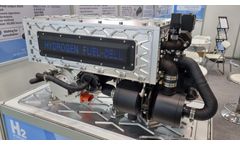fuel cell product Articles
-
Engineering models for fuel cell production management
Membrane electrode assemblies are the key components of proton exchange membrane fuel cells. The future demand for this product could grow exponentially if key technical challenges are successfully addressed including low cost mass production and reliable customer order fulfilment. This study reports on a multidisciplinary team effort to formulate and apply engineering models for managing the ...
-
Fuel cell backup power in Scotland
Plug Power Inc. has installed a GenCore® fuel cell product that is currently providing backup power to a remote cellular telecommunications tower in the United Kingdom. Plug Power is providing backup power to the remote cell tower in Elgin, Scotland, in collaboration with Orange, one of the world’s most advanced and fastest growing mobile communications companies; FDT Associates, provider of ...
-
Commercial Demonstration of a PEM Fuel Cell for Power Generation
The chlor-alkali industry, one of the largest chemical industries in India and growing at an annual rate of 3.3%, is expected to grow along with the growing Indian economy. This MW size proton-exchange membrane (PEM) fuel cell product captures hydrogen produced in the chlor-alkali industry to create on site electricity and provide plant operators up to 20% of electricity savings. The electricity ...
-
Hydrogen energy for the transportation sector in China
Hydrogen is a promising energy carrier for providing a clean, reliable and affordable energy supply. This paper provides a blueprint for the hydrogen energy in the transportation sector in the future of China. This paper is divided into three parts. The first part answers this question: why is China interested in hydrogen energy? The second part describes the possibility of a hydrogen fuel cell ...
-
An emerging approach for strategy evaluation in fuel cell development
This is the first research paper on the topic of Taiwan fuel cell development to combine the two theoretical (AHP and FMCDM) approaches. The conclusion suggests that the priority for Taiwan to develop fuel cells are the fields of 3C electronics, power generation equipment, motorcycles and automobiles. The difficulties the industry has encountered and faced, in turn, are the technology ...
-
Coming In Out of the Cold: Hybrids Put to the Test
Untitled Document Point Roberts, WA, Delta B.C.- May 25, 2004 With gas prices reaching an all time high and not much promise of an end in sight, hybrid technology is falling under the lens of some careful scrutiny these days with investors. In a recent article in MIT’s Technology Review, author Peter Fairley estimates “though buyers would have to pay more ...
-
South Africa`s fuel cell plan risks failure without support
An ambitious strategy to create fuel cell products for export will need incentives and cross-government backing to bear fruit, says Radhika Perrot. South Africa's Department of Science & Technology (DST) has been laboriously pushing for the development of hydrogen fuel-cell technology through an ambitious research and development (R&D) strategy since 2005. Fuel cells can convert the ...
By SciDev.Net
-
Reviewing the factors affecting regenerative molten carbonate fuel cells
To evaluate the possibility to use molten carbonate fuel cell technology for high temperature electrolysis, the factors affecting the electrode reactions have been examined by surveying the published literature. The literature results showed that H2, CO2 and CO evolved as cathode off–gases and O2 as anode gas. At low polarisation, the discharge of oxide ions to O2 was the only anodic process; ...
-
Solar powered solid oxide fuel cell with thermoelectric generator
Durable, location independent, environmental–friendly sources of energy which allow for modular, few moving parts, low operating noise, high electricity generation efficiency and compact technology are highly desirable. Solid oxide fuel cells (SOFCs) are promising for such energy system development, since they are energy efficient and, if pure hydrogen is used, have virtually no emissions of ...
-
Potential applications of amorphous/metallic glassy alloys as hydrogen-permeable membranes for hydrogen production and bipolar plates for PEFC
The potential of amorphous/metallic glassy alloys as hydrogen-permeable membranes for hydrogen production and as bipolar plates for Polymer Electrolyte Fuel Cells (PEFCs) was investigated in this paper. Firstly, the hydrogen permeation of the melt-spun (Ni0.6Nb0.4)70Zr30-xTax (x = 5, 10, 15, 20 at%) alloys was measured. As a result, it was found that the hydrogen permeability of the alloys ...
-
PHILOS and Blue FC Announce R&D and Business Cooperation to Revolutionize Fuel Cell Technology
PHILOS, a leading membrane technology manufacturing company, and Blue FC, a fuel cell system company, have announced a ground-breaking R&D and business cooperation that is set to revolutionize the fuel cell industry. The CEOs of both companies, Dr. Jeong-Hak Kim of PHILOS and Dr. Yong Sheen Hwang of Blue FC, have agreed to work together to develop innovative solutions using PHILOS's advanced ...
-
Controlling methanogenesis and improving power production of microbial fuel cell by lauric acid dosing
Methanogens compete with anodophiles for substrate and thus reduce the power generation and coulombic efficiency (CE) of the microbial fuel cell (MFC). Performance of a baked clayware membrane MFC inoculated with mixed anaerobic sludge pretreated with lauric acid was investigated in order to enhance power recovery by controlling methanogenesis. In the presence of lauric acid pretreated ...
-
Simultaneous domestic wastewater treatment and renewable energy production using microbial fuel cells (MFCs)
Microbial fuel cells (MFCs) can be used in wastewater treatment and to simultaneously produce electricity (renewable energy). MFC technology has already been applied successfully in lab-scale studies to treat domestic wastewater, focussing on organic matter removal and energy production. However, domestic wastewater also contains nitrogen that needs to be treated before being discharged. The goal ...
Need help finding the right suppliers? Try XPRT Sourcing. Let the XPRTs do the work for you


